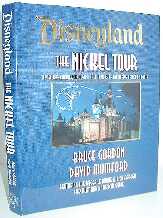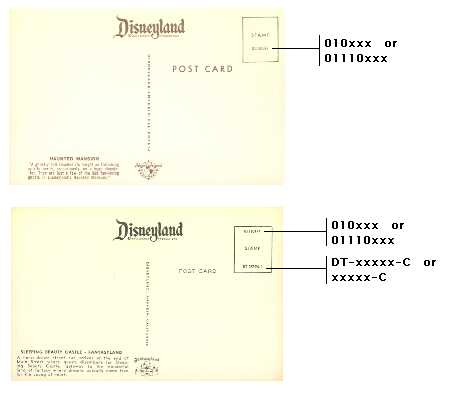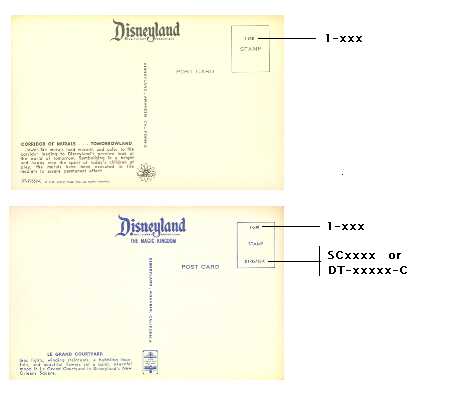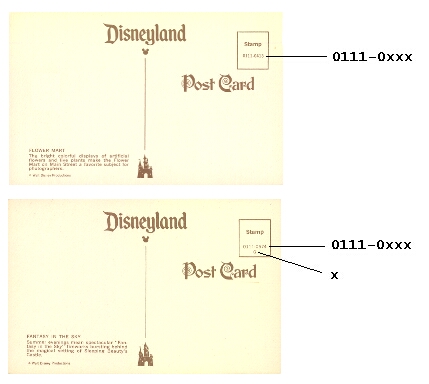
This file might be helpful to anyone who needs to know about Disneyland postcard serial numbers from the late '60s and early '70s, such as collectors and sellers. The statements here are only my own deductions, and are not based on any official source.
John Komlos tells me that the book Disneyland: The Nickel Tour has comprehensive information on Disneyland postcards. The second edition is still in print and costs about $75. There is a picture of this book on his web page Disneyland Paper Collection. Unfortunately I have never seen the book other than in pictures, so for the time being I am limited to my own deductions.

The first thing to know about postcard serial numbers is that they are frequently ambiguous and illogical. Sometimes the same serial number applies to different scenes, the primary numbers and their details aren't consistent, the numbers aren't always grouped by Land, and so on.
Next, there are different series of serial numbers.
For the era surrounding 1968 (the focus of this site),
there are two main numbering schemes:
For completeness I have listed all the series of which I am familiar below. The two series from 1968 have red titles.
These serial numbers start with a letter followed by a hyphen and number, such as C-14 or E-9.
This series predates the 0 series and 1 series, and ends around 1966-1967. I was able to buy letter series cards in 1966 but not in 1968. The end of the series was probably motivated in part by the addition of New Orleans Square in 1966, since there was no room to insert a letter between B and C. (And using the first letter of a Land would obviously cause problems with Frontierland and Fantasyland.)
Clearly the letters are codes for the Lands in clockwise order:
A-xx: Main Street
B-xx: Adventureland
C-xx: Frontierland
D-xx: Fantasyland
E-xx: Tomorrowland
As with the 1 series (described later), a letter series serial number does not always uniquely describe a scene. For example, I know of two versions of E-9 and two versions of E-10. In each case, the attractions photographed on the two versions are the same, but the views are slightly different.
Unlike the 0 series and 1 series (described later), details (described later) never appear in the letter series.
See my letter series file for a long list of specific postcards of this series.

This series began around 1966-1967, and continued until the mid-'70s.
The two photos above show that either one number or two numbers can be present on a given card. The difference is not very important. The number that starts with "0" must always be present. I call that number the primary number. If there are two numbers, the primary number is on top. The optional number that sometimes appears at the bottom is what I call the detail.
Within a span of primary numbers, the detail appears and disappears sporadically. The primary number in most cases is sufficient to uniquely identify the card. I've seen several people on eBay selling cards based only on the detail, but this is poor practice, since anyone who knows and is using the serial number scheme for classification is going to be organizing them by the primary number instead.
There are two different series of primary numbers: the "short" 0 series where the primary number has six digits (e.g., 010310), and the "long" 0 series where the primary number has eight digits (e.g., 01110545). This difference is not very important, either, since both 0-numbers work the same way: they are combined with the same type of details.
As for the detail, this is usually preceded by a "DT-". In only one case have I seen the "DT-" omitted (viz., 01110407/35938-C). The "-C" is always present in the 0 series detail.
The DT details sometimes descend while their primary numbers ascend. For example, on cards 01110407/35938-C and 01110410/DT-35920-C, the primary number has increased by 3, but the detail has decreased by 18.
I suspect the terminal "-C" stands for "Chrome" or "Color" but since I have never seen any serial numbers for black-and-white Disneyland postcards, I can't support this theory. I don't know what the "DT-" stands for. I do know that "T" cannot stand for "Tomorrowland" because non-Tomorrowland postcards also use the "DT-". The "D" could stand for "Disneyland" or "Disney," or the "DT-" could stand for "detail"--the same term I'm using.
An SC detail (discussed in the next section) is never present in the 0 series, only DT details.
The "short" 0 series primary numbers I have seen span at least 010283 through 010535, which is a span of at least 253 cards. The "long" 0 series primary numbers I have seen span at least 01110400 through 01110516, which is a span of at least 117 cards, assuming the numbers occupy the entire span between even hundreds. (It seems more likely the numbering is like hotel rooms: it starts anew at each even hundred, viz. at 400 and 500.) The DT details I have seen span at least DT-29559-C through DT-35947-C, which is a span of at least 6,389.

This series began around 1966-1967, and continued until the mid-'70s.
The 1 series is quite similar to the 0 series. Like the 0 series, a detail may or may not be present in the 1 series. Most of the details I've seen for the 1 series are of the form SCxxxx (e.g., SC8568), but a few have the DT form usually associated with the 0 series (e.g., DT-29559-C). Whereas either DT or SC forms may exist in the 1 series, only the DT form can appear in the 0 series, never SC.
Often the method by which different scenes are identified is not by different SC details on each card, but by a card without an SC detail, versus a card with an SC detail. For example, card 1-280 of Schweitzer Falls has no SC detail, but 1-280/SC8570 of Schweitzer Falls with the same caption but a different scene does have an SC number.
An SC detail number increments by 1 whenever it appears in the series, and doesn't increment when it is does not appear. For example, card 1-279 has SC8569, and the next card in the sequence, card 1-280, has SC8570, which is also incremented by 1. However, cards 1-280/SC8570 and 1-282/SC8571 have incremented their primary numbers by 2, but their details by only 1, since there was no SC detail for the intermediate card 1-281.
Sometimes when SC details are needed to differentiate between scenes, they are inexplicably omitted. For example, cards 1-280 and 1-280/SC8570 of different scenes of Schweitzer Falls are differentiated by the SC detail, but the very next card in the series, card 1-281, has two versions with different scenes of the elephant pool, but no SC detail in either case. Therefore serial numbers do not always uniquely identify scenes on old Disneyland postcards.
I've seen one card with the "DT" detail duplicated at the bottom of the card, underneath the caption (viz., 1-348/DT-29559-C).
The "SC" may stand for "scene," since I've seen cards with the same primary number and same caption, but which had different scenes and different details.
The 1 series primary numbers I have seen span at least 1-277 through 1-538, which is a span of at least 262 cards. The SC details I have seen span at least SC8568 through SC8571, which is a span of at least 4.

This series began to appear around the mid-'70s.
In addition to the hyphenated serial number that begins with "0",
cards in this series are characterized by:
The hyphenated 0 series appears to function very similarly to the 0 series. Within this series the detail is a single letter that appears and disappears sporadically, on the line below the primary number, in contrast to the several-digit DT and SC numbers of the 0 series and 1 series.
The only such details I have seen all correspond to the same primary number:
0111-0574/C (Fantasyland)
0111-0574/E (Fantasyland)
0111-0574/G (Fantasyland)
The hyphenated numbers coincide with the unhyphenated numbers for the same attractions, so it looks as if this series was intended to replace the earlier (unhyphenated) 0 series. For example, card 01110512 of Matterhorn climbers and card 0111-0512 of a Matterhorn bobsled have the same serial number except for the hyphen, and are of the same attraction.
I'm sure even more series exist, such as the series of unusually long cards, the 3-dimensional cards, the watercolor art cards, and other Hallmark cards. There are also cards produced outside of the Disney company that show the key Disneyland attractions.
Associating Disneyland postcard serial numbers with years is a real chore without a reference book, at least for the circa 1968 era. In only one case have I seen a year on an old Disneyland postcard from this era. However, it is possible to go by various clues, which I have done below.
The following fragments of information may be of some help. These date ranges assume that: (1) Postcard serial numbers are strictly chronological; (2) The photographs were taken after the attraction opened to the public. ("=" means certainly equal to that date, ">=" means on or after that date.)
short 0 series
long 0 series
1 series



Updated: March 1, 2002